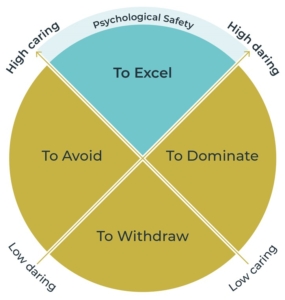
In Madeleine’s team, Peter has an individual conversation with each team member. In these conversations, it becomes clear that a number of team members feel unsafe. Another few are disappointed in the organization.
Several people miss their previous supervisor Esther who left unexpectedly due to illness.
And there is another group that feels that Madeleine is not vigorous enough, which is why they have given up.
So there are big differences between people. Because these differences are not openly discussed within the team, it seems as if people are connected, but agreements made are not honored and objectives set are not achieved. It seems safe within the team, but it is not. In fact, there is more of a false sense of security. Team members become inactive, start to lean back and adopt a mindset of avoidance and withdrawal. Peter enters into a conversation with Madeleine and reflects on the common thread of what he discovered in the conversations. She is visibly shocked. “What are you shocked about?”, Peter asks. “That this is happening again. In my previous team it happened too and I didn’t manage to turn the tide, no matter how hard I tried to do it right.”
Madeleine tells Peter how hard she is working. She tells him that in the team she often emphasizes that team members can always come to her and that the group is a safe space where they can discuss anything. Madeleine realizes that this pattern is repeated in her leadership. Her frustration with the lack of real change in the dynamic has caused her to try harder and harder to strengthen the connection. She knows this pattern well. Even in her younger years, what she did never seemed good enough. She tried harder and harder to please her parents. A self-fulfilling prophecy: she achieved exactly the opposite of what she was striving for. A pattern that repeats itself in her managerial role. Peter explores this old pattern with her to help her free herself from the suffocating desire to chase something she can only get from others when it gives to herself: love.
The team coach as a secure base: connecting and challenging
Two patterns are always visible in people’s bonding styles: caring on the one hand, daring on the other. A secure base strives to achieve an optimal balance between these two movements. What is a secure base? It is a source that makes us feel welcome and which inspires and encourages us to face the challenges that life throws at us together (Jakob van Wielink, Riet Fiddelaers-Jaspers & Leo Wilhelm). This source is caring because of the connection it makes and the trust and safety it provides. At the same time, it is also daring through the encouragement and challenge it gives to his people. The team coach can create the conditions to be close to one another in the team so that team members can get to know one another better. If this closeness leads to more understanding of and for each other, security increases and more risks can be taken. You could call this the magic of psychological safety. This psychological safety allows the team to excel and the team to learn, develop and innovate.
Window of Excellence: Klaartje van Gasteren, Marnix Reijmerink and Jakob van Wielink.
Download Article













